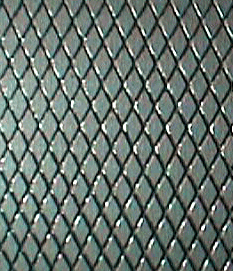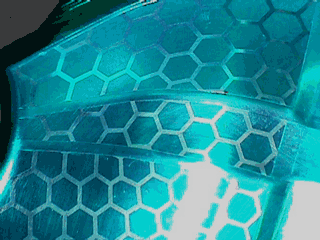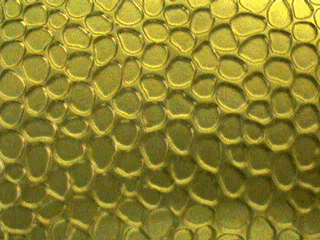






Mold Texturing
The Akron Metal Etching Company is offering this as a guide to assist you in producing a part with as low a percentage of blemishes due to "flows," "sinks," etc. as possible while maintaining an efficient production rate and an attractive appearance. There are so many variables that we can only give you "rules of thumb" gained from experience related to us by you, our customers.
Designs or Textures: We have in our files over 2,000 textures, which can be applied in a single process. Multiple process textures are often a combination of a single process texture, but have at least two or more carefully controlled depths, providing a more uneven appearance and surface. Requiring more effort to produce, the multiple process textures cost more than single process textures. Designs or lettering that can be drawn or reproduced in black and white can be etched into a mold with certain limits relating to depth of design, mold draft, type of material to be molded, and complexity of contour. Please send us your pattern or design and we will discuss it with you.
Handling: While handling molds during the etching process we are required to turn them various ways. For easier handling, eyebolt holes in opposite sides of the molds are necessary. Please remove locating and/or guide pins in order to assist us in providing you with better service.
Metals: Texturing has been done on practically all regular tool steels, cast tool steel, both hardened and unhardened, as well as copper alloys, 400 series stainless steel, cast iron, kirksite, bronze, brass and aluminum. Having textured quite a number of cast and forged aluminum molds for blow-molding, we have found that forged aluminum of 6001 T6 alloy is far more satisfactory to both the user and to our process. Cast metals often have areas of porosity beneath the surface to be textured. These areas are often exposed during the etching process and we cannot be responsible for this porosity. Tool steel containing combinations of high chrome, nickel or molybdenum must be test etched prior to quoting prices and for feasibility.
Surface Preparation: Mold surface finish is important. The finer the design, the better the finish required. This can range from approximately 220-grit paper to an A-1 finish. In surface grinding and benching, care must be taken to avoid galling or burnishing effects. All Electrical Discharge Machining scale must be removed from the area to be textured in order to provide the quality of etching that you as a customer are entitled to. In the course of "burning," the tool surface becomes very hard forming a "skin," uneven in thickness, which may break down at different times during the etching process giving an uneven depth of etching.
Depth of Texture: The character of the texture or design itself determines how deeply it can be etched into a cavity. Finer or more delicate textures usually are quite shallow-in the order of .0005" to .0015" deep. Coarser or heavier designs often can be etched from .007" to .025" deep.
Draft Angles: Mold draft angles must be sufficient to release the textured part without scuffing. We suggest that you allow 1 degree of draft per sidewall per .00075" depth of texture. A minimum draft allowance should be 1 degree more draft per sidewall than the depth of the etching, i.e., 4 degress draft for .003" texture. Many textures have a direction of grain and if etched with the direction of draw, can facilitate removal of the piece from the mold.
Welds: We try to do the best job possible with the welded areas, but cannot guarantee a perfect match due to the variation in hardness, porosity, metal grain structure and color. The area to be textured should be free of welds, but if welding is necessary, it should be made using the parent metal as a rod or a slightly lower carbon rod and the welded area "drawn" to match the parent metal in hardness. Pre-heating the surrounding area will help minimize the hardness difference between the parent metal and the weld.
Damaged Texture: Before attempting any repair of the damaged texture, contact us! We may be able to suggest a way to save time and money in the process of repairing the textured area.
Plating: A mold containing textured areas can usually be "flash" plated without changing the texture character. If a moldhas been plated, it must be thoroughly stripped before proceeding with the repair.
Delivery: Delivery time depends upon a combination of factors such as design selected, areas to be protected, size of mold, etc. Normally, the design is established before the receipt of the mold, so the preliminary work is completed when the mold arrives. This is particularly helpful when artwork is required. The usual production time is four to six working days.
Pricing: Prices are not based on area serviced. Each job is figured individually because each job is different. Prices are affected by configuration of the cavaties, amount of protection needed, texture to be used, and the type of material to be textured. An estimate can usually be made from mold or part drawings, or molded pieces clearly marked to show parting lines, areas to be textured, and if any ejector pins and inserts to be textured. There is no price per square inch. In order to be of further service to our customers, we try to give "ball park" phone estimates for texturing to aid you in estimating prices.
Texturing the Mold: The customer normally sends us only the part of the mold to be textured. Any shutoff or other areas not self-deliniating should be scribed into the metal along with mold prints, clearly marked to show areas to be textured. If a part is available, it is often best to mark the part to show the textured areas. If the mold is to produce a part to match a previously textured part, please send a part and inform us they are to match.
Mold Size: Our experience includes texturing mold sections up to seven tons for house doors, shutter molds, table tops, car mats, TV fronts and backs, hair dryers, lawn furniture, wastebaskets, air conditioners, bowls, tumblers, tool boxes, tackle boxes, luggage, and other items ranging in size from plates 17 feet long by 5 feet wide to push buttons for dishwashers.
Satinizing: A registered trademark of Akron Metal Etching for the method of softening textures, and improving part release from the mold. This can be done in varying degrees depending upon roundness desired and the depth of the initial texture.